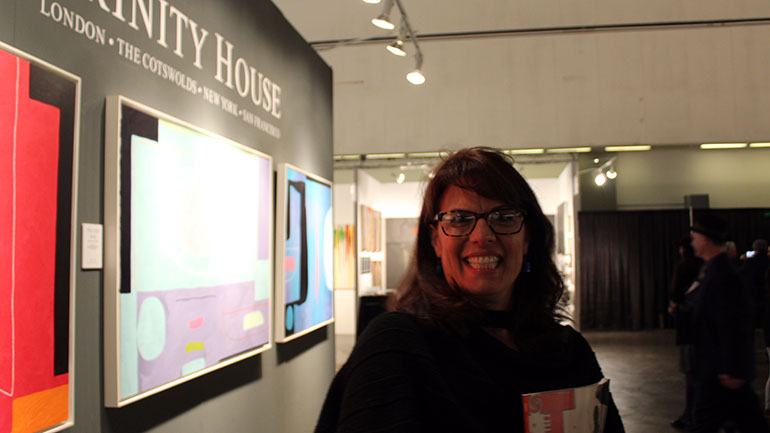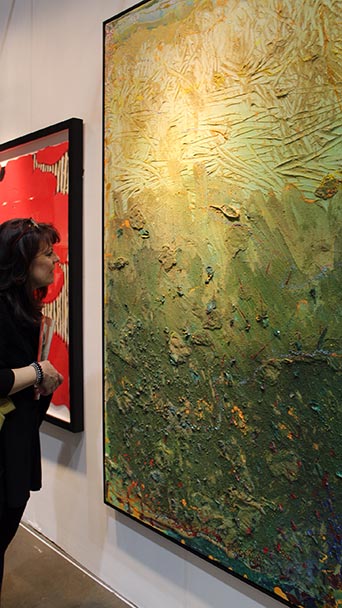Review By
Janice Bremec Blum
* this article is a spoiler alert
The latest movie to hit Netflix is Velvet Buzzsaw, by director Dan Gilroy. It is a horror-thriller that takes place in an unsuspected arena, the niche world of art. I recently attended the LA Art Show at the Los Angeles Convention Center that reminded me of the art show depicted in the film. Walking around the gallery booths, I wondered about the whys of contemporary, modern art. Why did the artist choose the subject or non-subject? Why did the gallery choose the art? Why is one piece worth more than another piece? For those of us not in the inner circle of the contemporary arts—the ones who bravely voice “huh?” while in an art gallery—the film opened the door to the lives of those who can answer the whys. Or rather, those who we are lead to believe have the answers. All art is subjective, but when we lack an advanced fine art education, there is a tendency to rely on someone else’s tastes and claim them as our own. No need to risk judgement of your intelligence about the elusive world of art when you can merely agree with an esteemed critic, gallery owner, or dealer. It is intellectual survival. If you can’t beat’em, join’em. What I found interesting about this film was the art itself retaliated against those of proclaimed authority. It was the artwork’s creative survival. The art didn’t join’em, they beat’em. To death.
This is not a critique of the film, but more of a sidebar look at how the film represented those in the upper-crust art world and how that representation affects how we perceive and value art. Jake Gyllenhaal plays art critic Morph Vandewalt, who is a somewhat hackneyed version of perhaps what laymen would assume an art critic to be. Sexually fluid, eccentric, circumspect, haute couture fashionable (with serious Hollywood six-pack abs) and brimming over with an elitist attitude. Wrapped in that fabric why would anyone challenge his art reviews when his persona mimics the indefinability of art itself? When a clichéd character like Morph says “go,” we all race to the finish line without bothering to ask why we’re running. This is where our personal tastes become skewed by a stereotype.
Rene Russo plays gallerist Rhodora Haze, who is equally painted with the hackneyed brush. She’s a high-status, no-nonsense woman who demands respect along with her morning Starbucks. When her employee Josephina, stumbles upon unclaimed art left by her dead neighbor, Josephina immediately connects with the pieces. When Rhodora views the artwork, she doesn’t praise Josephina’s eye or the artist’s talent; she sees a financial boon. When Morph deems the posthumous artist’s work a sensation, it ultimately sets a lofty price for the pieces as well as a demand. Based on his favorable evaluation, Rhodora sets the bar even higher. It’s word-of-mouth advertising that values money more than it values art. Everyone wants a piece of the prosperous pie, but in the end, money is not the winner. The artwork itself is the victor.
Art wins the race over the wallet.
These are matters we need to bear in mind when we go to an art gallery, a museum, or the next LA Art Show. Is a piece so aesthetically superior it is worthy of a hefty price tag, or are we merely listening to art world denizens telling us it is? A true artist puts their heart and soul into their work. When critics, dealers, or gallerists sell an artist’s work, oftentimes the soul of that creation gets lost, hidden amongst dollar signs tainted by pretentious elitists. Despite the gore in the film, it was refreshing to see the art set the standards rather than the artsy. One by one, the artsy clique meets their demise by personified disgruntled artwork in all forms, including the titular tattoo on Rhodora’s back.
In a non-gory scene, a man finds the highly acclaimed deceased artist’s work by the side of the road and he, like the gallerist, jumps on a financial opportunity. He hangs the pieces on a chain-link fence next to a sidewalk. When a passerby admires a painting, the purchase price is far, far less than what would have been fetched at a high-flatulent gallery. The purchaser pays the five-dollar street price because they liked the painting. Ultimately, the purchaser does not meet the same deadly fate as the others. I’d like to believe that it’s because the art was finally appreciated for what it is rather than the price it can fetch.
Next time you find yourself in a gallery, there is only one aesthetic opinion to listen to, your own. Whether the piece is nothing but a blue dot on a white canvas or a cornucopia of squiggly lines using every color in the Crayola box, if it resonates with you, then it is worthy art. You don’t need a Morph or a Rhodora to dictate your preferences. Allow art to be art rather than an investment to elevate your status based on someone else’s judgement. I promise, that when you appreciate art and let it speak to you, it will appreciate you right back. And won’t kill you.
Our review of the 2019 LA Art Show

Janice Bremec Blum
Editor-In-Chief
Janice is a rom/com novelist and a multi talented make-up artist with an MFA in Creative Writing from Antioch University. “The best part about L.A.,” says Janice, “it’s so diverse and encompasses many different ethnicities and yet no matter who we are or where we hail from, at some point, we will all find ourselves stuck on the 405!” Janice, a fiction Romance comedy writer lives with her husband Hunter in Los Angeles and they are both art collectors. You can email Janice at janice@tribelamagazine.com.



